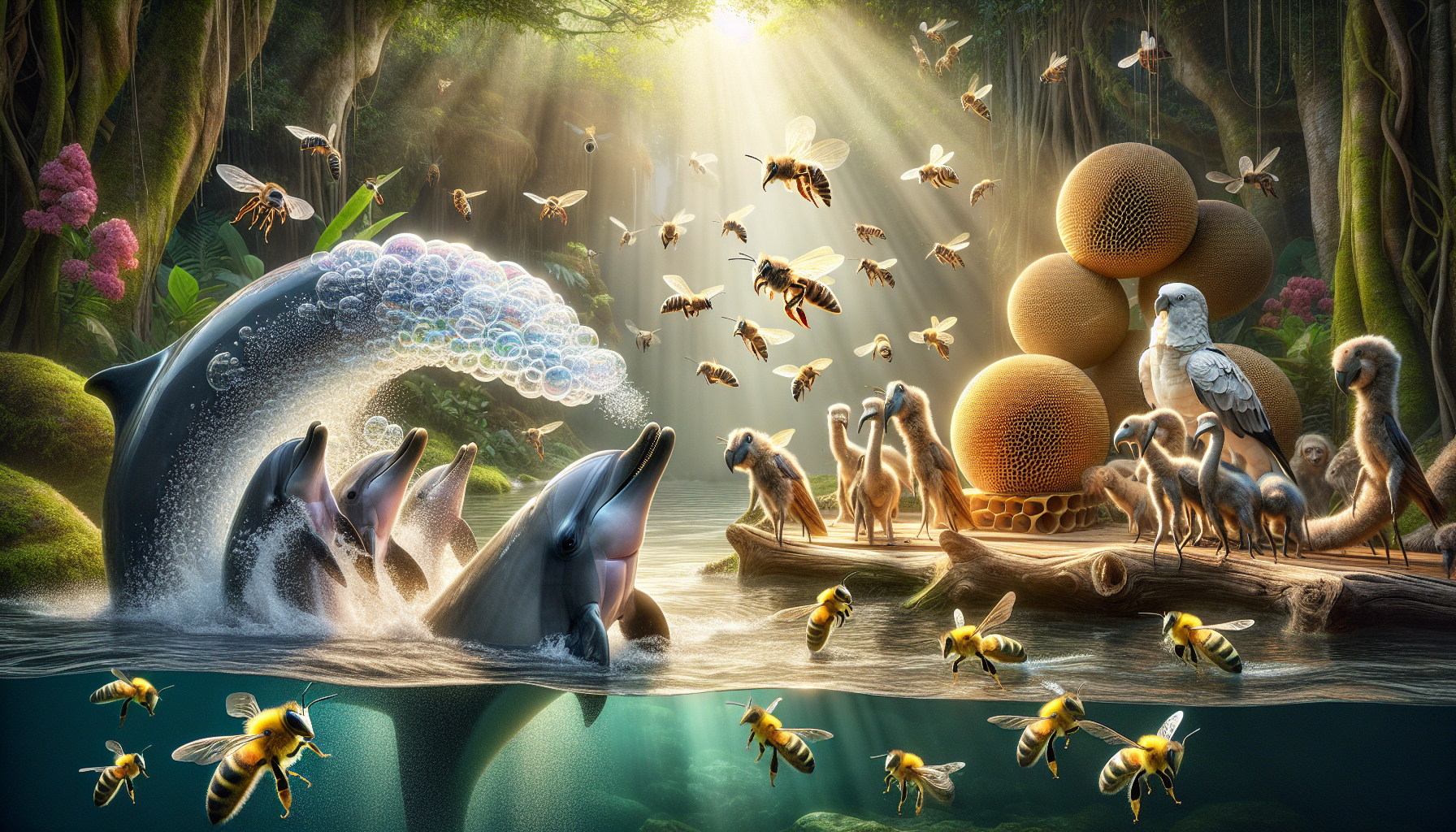In a world increasingly dominated by human language and communication, it’s easy to overlook the vast tapestry of non-human languages that envelop us. From the complex dances of honeybees to the haunting songs of whales, nature is a symphony of communication that often goes unnoticed. The evolution of these non-human languages is not just a fascinating study of biology and linguistics, but a testament to the ingenuity and adaptability of life itself. 🌍 As we delve into the world of non-human communication, we uncover stories of intelligence, survival, and connection that challenge our very understanding of language.
The journey of breaking barriers in communication is a remarkable one. It begins with the smallest creatures—ants, bees, and even bacteria—whose sophisticated methods of information exchange have been honed over millions of years. These tiny communicators use chemical signals and physical movements to coordinate activities that ensure the survival of their colonies. Ants, for instance, employ pheromones to map out intricate trails to food sources, a language written invisibly on the ground. In the depths of the ocean, the clicks and whistles of dolphins paint a picture of a world where sound is the most precious currency. These marine mammals have developed a language so rich and nuanced that it rivals even our own in complexity.
As we continue to explore, we find ourselves in the dense canopy of rainforests, where primates engage in vocalizations and gestures that convey emotions and intentions. The great apes, our closest relatives, have shown an ability to learn elements of human sign language, bridging the gap between our worlds. This interspecies communication raises profound questions about the nature of language and consciousness. 🐒 It invites us to reconsider what it means to be sentient and how we define intelligence. Are these creatures truly speaking a language, or are they simply mimicking human actions? As we ponder these questions, we realize that understanding non-human languages could unlock new dimensions of empathy and coexistence.
This exploration of non-human communication is more than an academic pursuit; it’s a journey that touches on ethics, technology, and the future of our planet. As we learn to interpret these languages, we are faced with the responsibility of protecting the voices of the natural world. With technology advancing at an unprecedented pace, we now have tools that allow us to decode the languages of other species with greater accuracy than ever before. This technological evolution has opened new avenues for conservation efforts, enabling us to create better strategies to protect endangered species and preserve their habitats. 🌱 As we embark on this adventure through the pages of this article, we will examine the groundbreaking research that is transforming our understanding of animal communication, explore the ethical implications of these discoveries, and envision a future where humans and non-humans coexist in harmony.
The Intricacies of Animal Communication
The realm of animal communication is a fascinating and complex field that continues to baffle and intrigue researchers worldwide. It involves an array of signals and modalities, ranging from the vocalizations of birds and the dances of bees to the chemical signals of ants and the bioluminescent signals of marine creatures. Each form of communication has evolved uniquely to suit the ecological and social needs of the species. This diversity underscores the adaptability and inventiveness of non-human communication systems. 🤔
One of the most well-studied examples is the dance language of honeybees. When a foraging bee discovers a new food source, it returns to the hive and performs a “waggle dance” to communicate the location to its fellow bees. This dance conveys direction and distance information relative to the sun’s position. It is a striking example of how non-verbal signals can convey complex information efficiently and effectively. This discovery, made by Karl von Frisch in the 20th century, highlighted the sophistication of animal communication systems, challenging the notion that human language is uniquely complex. To delve deeper into the remarkable dance of bees, watch this informative video by TED-Ed.
Another compelling example is the vocal communication of dolphins. Dolphins are known for their high intelligence and social nature, which is reflected in their communication abilities. They utilize a complex system of clicks, whistles, and body language to convey messages to one another. Research suggests that dolphins may even have signature whistles akin to human names, allowing individual identification and social bonding within pods. This form of communication demonstrates a level of social complexity that rivals many human interactions. For a captivating overview of dolphin communication, consider watching this documentary by Nature on PBS.
Understanding the Mechanisms
The mechanisms underlying animal communication are as diverse as the species themselves. Each method has evolved to suit the specific ecological niches and social structures of the animals. For instance, birds are known for their elaborate vocalizations, which play critical roles in mating, territory defense, and social interactions. These vocalizations are often species-specific, and in some cases, individuals within a species may have unique calls that function like personal identifiers.
Similarly, chemical communication is prevalent in insects like ants and termites. These creatures use pheromones to communicate information about food sources, danger, and reproductive status. This form of communication is incredibly efficient in their densely populated colonies, enabling the maintenance of social order and coordination. It underscores how non-verbal forms of communication can be highly effective, even in the absence of vocalizations.
In marine environments, creatures like cuttlefish and octopuses employ chromatophores and bioluminescence to communicate. These abilities allow them to change colors rapidly, sending signals about aggression, mating readiness, and camouflage. Such adaptations are crucial for survival in the visually complex underwater world. The ability to convey information visually, without sound or physical contact, demonstrates the extraordinary flexibility and inventiveness of communication strategies in the animal kingdom.
Comparative Analysis of Communication Methods
The diversity of communication methods among non-human species prompts intriguing comparisons with human language. While human language is predominantly auditory and verbal, many animals rely on multi-modal communication systems that integrate visual, chemical, and auditory signals. This diversity reflects the evolutionary pressures and environmental constraints that shaped each species’ communicative abilities.
To illustrate these differences, consider the following table that compares the communication methods of selected species:
| Species | Primary Communication Method | Purpose | Complexity |
|---|---|---|---|
| Honeybees | Dance and Chemical Signals | Food Location, Colony Coordination | High |
| Dolphins | Vocalizations | Social Interaction, Identification | High |
| Cuttlefish | Color Change | Mating, Camouflage | Moderate |
| Ants | Chemical Signals | Colony Coordination, Foraging | Moderate |
The table above highlights the various ways in which animals communicate, underscoring both the complexity and specificity of their communication methods. For example, while honeybees and ants both utilize chemical signals, the purpose and complexity of their communication differ significantly, tailored to their distinct social structures and ecological roles.
Challenges and Future Directions
Despite significant advances in understanding non-human communication, numerous challenges remain. One primary obstacle is the difficulty in interpreting the meaning and intention behind animal signals, especially those that are non-verbal. Unlike human languages, which can be transcribed and analyzed, many animal communication systems are context-dependent and may change based on environmental or social factors.
Moreover, ethical considerations play a crucial role in studying animal communication. Researchers must ensure that their methods do not harm or distress the animals, particularly when conducting experiments or field observations. The development of non-invasive techniques, such as acoustic monitoring and computer modeling, has advanced the field significantly, allowing for more detailed and ethical studies of animal communication.
Looking ahead, interdisciplinary collaborations hold the potential to unlock further insights into animal communication. By integrating perspectives from biology, linguistics, cognitive science, and technology, researchers can develop more comprehensive models that capture the intricacies of non-human languages. Such efforts could lead to breakthroughs in understanding the cognitive capabilities of animals, offering profound implications for conservation and our understanding of intelligence across species.
- Explore the diverse communication strategies of animals in this video by National Geographic.
- Consider the ethical implications of studying animal communication and the importance of non-invasive methods.
- Stay informed about interdisciplinary approaches that promise to advance our understanding of animal communication.

Conclusion
In concluding our exploration of “Breaking Barriers: The Evolution of Communication in Non-Human Languages,” we find ourselves at the intersection of wonder and understanding, where science and nature intertwine to reveal the intricate communication systems of non-human species. Throughout the article, we have traversed the fascinating journey of communication, examining how various species—from dolphins and bees to primates and birds—utilize complex signals to convey information, emotions, and intentions. This journey has not only expanded our understanding of animal behavior but also challenged us to rethink the boundaries of language and communication.
At the heart of our discussion lies the recognition that communication is not solely a human domain. Dolphins, for instance, employ a sophisticated language system that includes clicks, whistles, and body movements, allowing them to navigate their social and physical environments with remarkable precision. Similarly, bees perform the intricate “waggle dance” to inform their hive mates of the location of food sources, showcasing a form of communication that is both efficient and essential for their survival.
Primates, our closest evolutionary relatives, demonstrate an impressive range of vocalizations and gestures that parallel aspects of human language. Studies have shown that chimpanzees and bonobos can learn and use sign language, highlighting their capacity for symbolic communication. Birds, too, exhibit a rich tapestry of vocalizations and songs, some of which are learned and culturally transmitted across generations.
The importance of these findings extends beyond academic curiosity. Understanding non-human communication systems enriches our appreciation of the cognitive and emotional lives of other species. It also underscores the evolutionary continuity that connects all life on Earth, reminding us that the roots of human language are deeply embedded in the broader tree of life.
Furthermore, the study of non-human communication has practical implications for conservation efforts. By decoding the ways animals communicate, we can better protect endangered species and their habitats. For example, understanding the communication patterns of elephants can aid in developing strategies to mitigate human-elephant conflicts and preserve these majestic creatures.
As we reflect on the journey through non-human languages, it becomes clear that these systems are not merely a reflection of survival mechanisms but are indicative of the rich social structures and emotional lives of animals. The evolution of communication in non-human species prompts us to question the exclusivity of human language and to recognize the diverse expressions of intelligence and empathy in the animal kingdom.
In conclusion, the exploration of non-human communication is a testament to the remarkable adaptability and complexity of life on Earth. It invites us to celebrate the diversity of communicative practices and to embrace a more inclusive understanding of language. As we continue to break barriers in our understanding of communication, let us be inspired by the resilience and creativity of the natural world. 🌍
We encourage you, dear reader, to share your thoughts and reflections on this topic. Engage in discussions, share this knowledge with others, and consider how the insights gained here might be applied in your own life, whether in fostering a deeper connection with nature or advocating for the preservation of endangered species. Let us continue this journey of discovery together, breaking barriers and building bridges across the vast tapestry of life.
For further exploration, consider diving into resources such as the National Geographic or Scientific American for ongoing research and developments in the field of animal communication. 📚
Thank you for joining us in this exploration. Your curiosity and engagement are vital to the ongoing conversation about the evolution of communication in the natural world. Let us continue to learn, share, and inspire each other in the pursuit of knowledge and understanding. 🌟
Toni Santos is a visual cryptographer and artisan, weaving hidden meaning into every line, curve, and composition. His creations delve into the mysterious world of secret codes, symbolic alphabets, and invented languages, transforming visual art into a rich tapestry of communication beyond words.
Guided by a lifelong fascination with hidden knowledge and the power of symbols, Toni explores how meaning can be embedded, concealed, and rediscovered. From constructed glyphs to encoded illustrations, each piece he creates serves as a portal to a deeper layer of understanding — one that invites curiosity, interpretation, and wonder. His work bridges the intuitive with the intellectual, the mystical with the methodical.
With roots in handcrafted artistry and a background in visual semiotics, Toni fuses form and function to create works that whisper rather than shout. These are not just images — they are visual riddles, poetic encryptions, and artifacts of a language yet to be spoken.
As the creative mind behind Vizovex, Toni offers a space where art meets encryption, and viewers are invited to decode, reflect, and engage. Through symbolic design, visual lexicons, and explorations into constructed languages, he builds a universe where meaning is layered, intentional, and always slightly out of reach — waiting to be discovered.
His work is a tribute to:
The unseen languages that shape our perception
The art of hidden messages and symbolic systems
The thrill of decoding and the beauty of mystery
Whether you’re a language lover, a codebreaker at heart, or someone drawn to the enigmatic, Toni invites you to explore a world where expression transcends convention — one glyph, one message, one mystery at a time.




